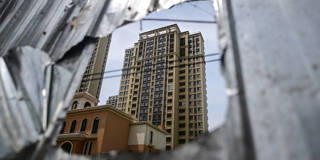Owing to the one-child policy and the legacies of other less-appreciated Chinese development measures over the years, the stage has long been set for today's property bubble. Even more worryingly, much of China’s economic growth over the past decade has been an overdraft on future growth that now may never materialize.
MADISON, WISCONSIN – China’s property sector is the largest asset class in the world – larger even than the US equity or bond market. But there are growing fears that it is a bubble poised to burst. Already, the heavily indebted Chinese property giant Evergrande has filed for bankruptcy protection in the United States, and the real-estate developer Country Garden is battling a liquidity crisis. The failure of either, or both, could well trigger a financial crisis.
But why did a property bubble emerge in the first place? Like so many other problems in China today, this one can be traced back to the one-child policy that the government adopted in 1980 – a decision that would fundamentally reshape the country’s economic, political, and diplomatic trajectory. At the time, Chinese policymakers believed that the country had only around 1.4 billion mu (a Chinese metric equal to 1/15th of a hectare) of arable land, and per capita arable land only 40% the size of India’s. So, they concluded that births would need to be capped, and urban land restricted.
This conclusion proved to be deeply flawed. For starters, in 1996, satellite telemetry revealed that China actually had 1.95 billion mu of arable land. Even if the initial estimate had been correct, however, arable land does not necessarily correlate with grain production, which is affected by many factors. In 2022, China’s arable land area was only 77% the size of India’s, but its grain output was twice as high.

MADISON, WISCONSIN – China’s property sector is the largest asset class in the world – larger even than the US equity or bond market. But there are growing fears that it is a bubble poised to burst. Already, the heavily indebted Chinese property giant Evergrande has filed for bankruptcy protection in the United States, and the real-estate developer Country Garden is battling a liquidity crisis. The failure of either, or both, could well trigger a financial crisis.
But why did a property bubble emerge in the first place? Like so many other problems in China today, this one can be traced back to the one-child policy that the government adopted in 1980 – a decision that would fundamentally reshape the country’s economic, political, and diplomatic trajectory. At the time, Chinese policymakers believed that the country had only around 1.4 billion mu (a Chinese metric equal to 1/15th of a hectare) of arable land, and per capita arable land only 40% the size of India’s. So, they concluded that births would need to be capped, and urban land restricted.
This conclusion proved to be deeply flawed. For starters, in 1996, satellite telemetry revealed that China actually had 1.95 billion mu of arable land. Even if the initial estimate had been correct, however, arable land does not necessarily correlate with grain production, which is affected by many factors. In 2022, China’s arable land area was only 77% the size of India’s, but its grain output was twice as high.